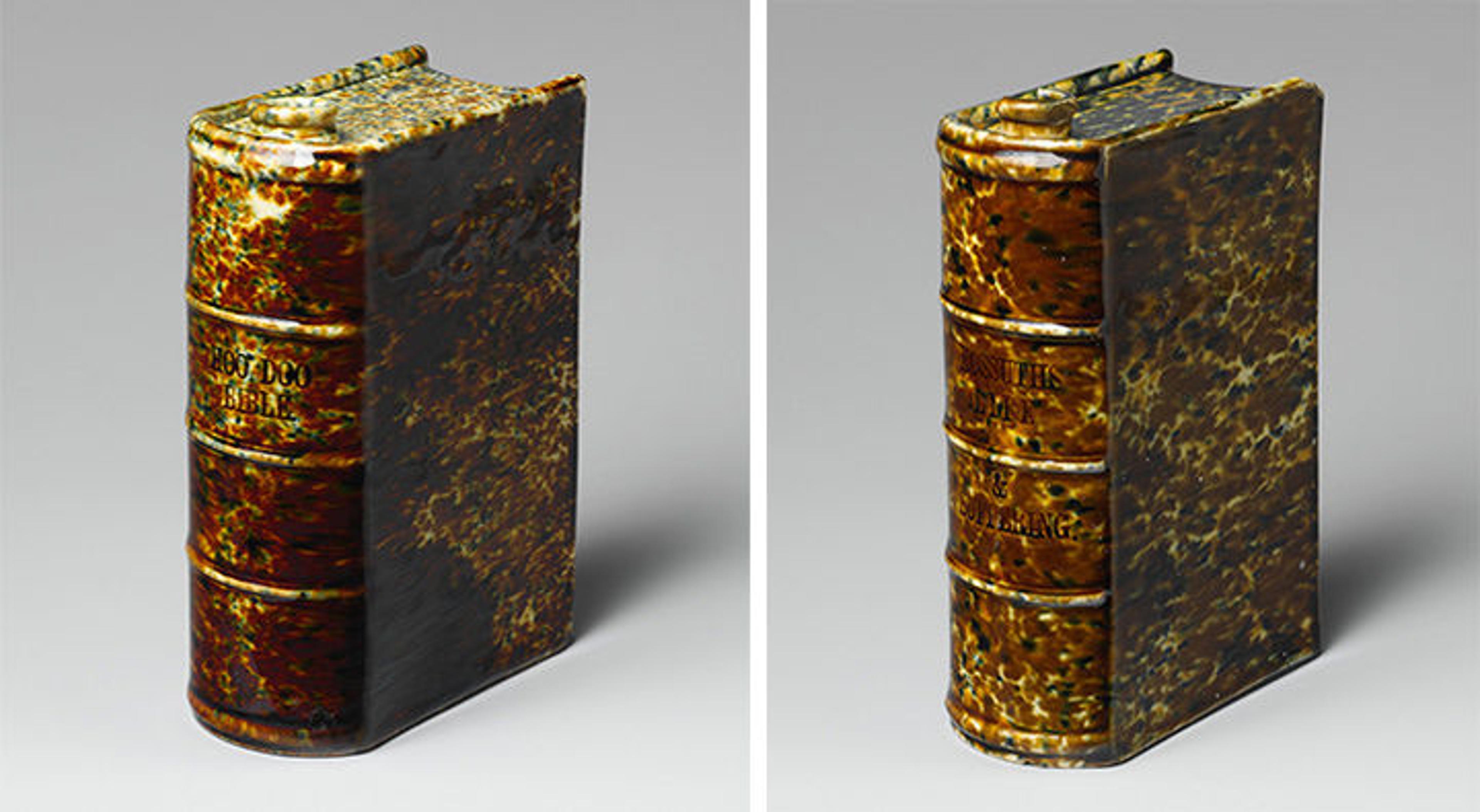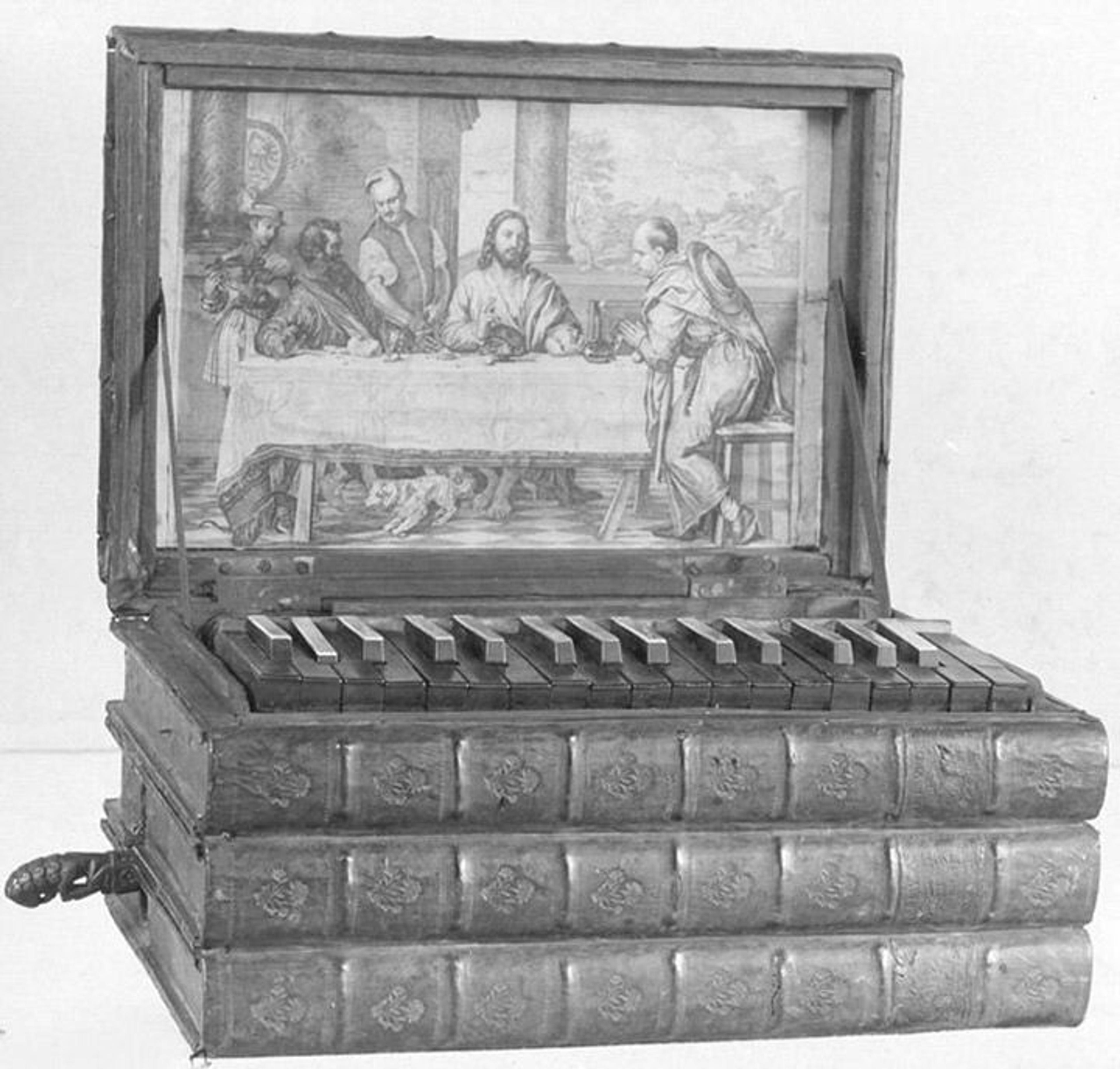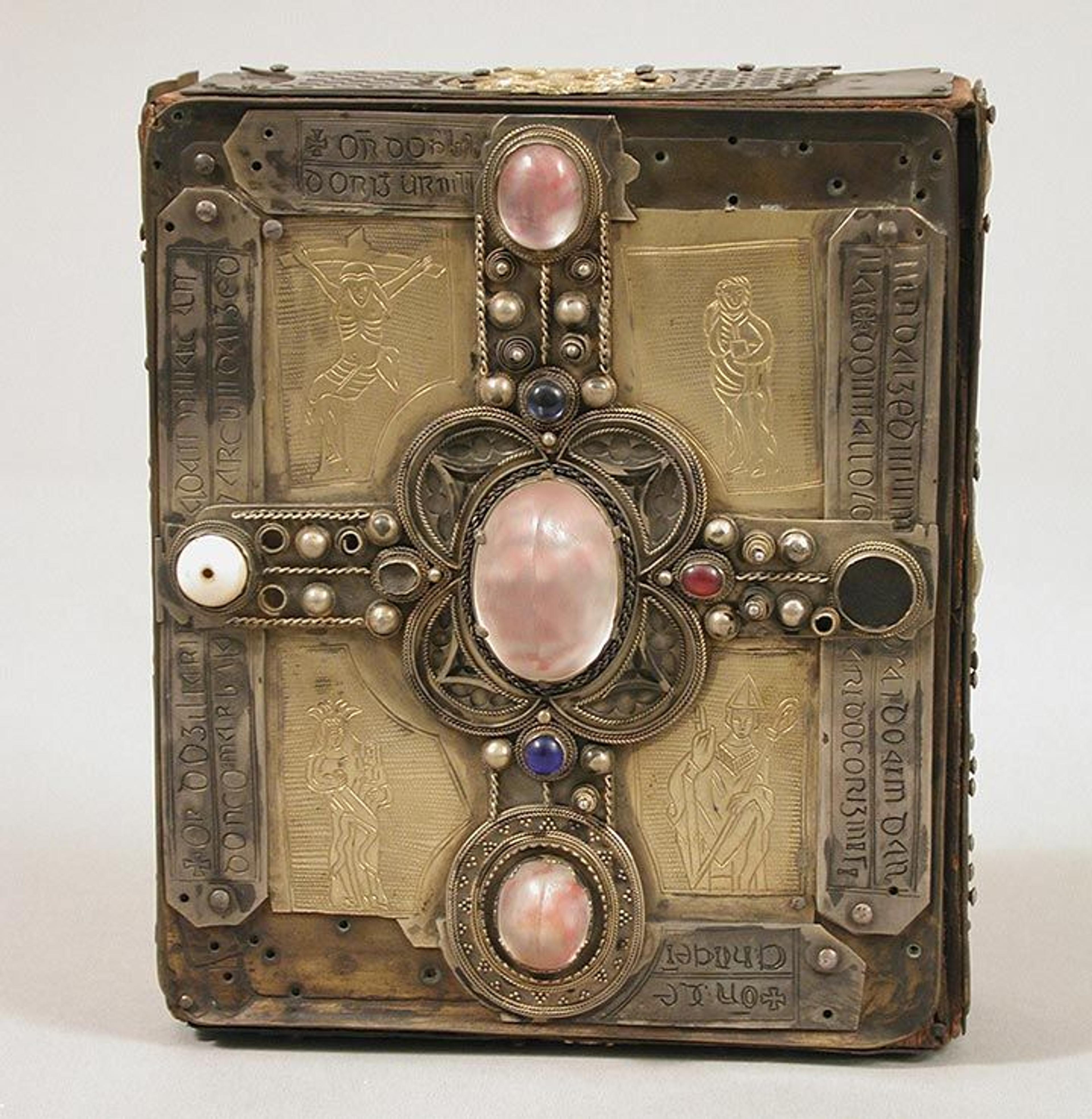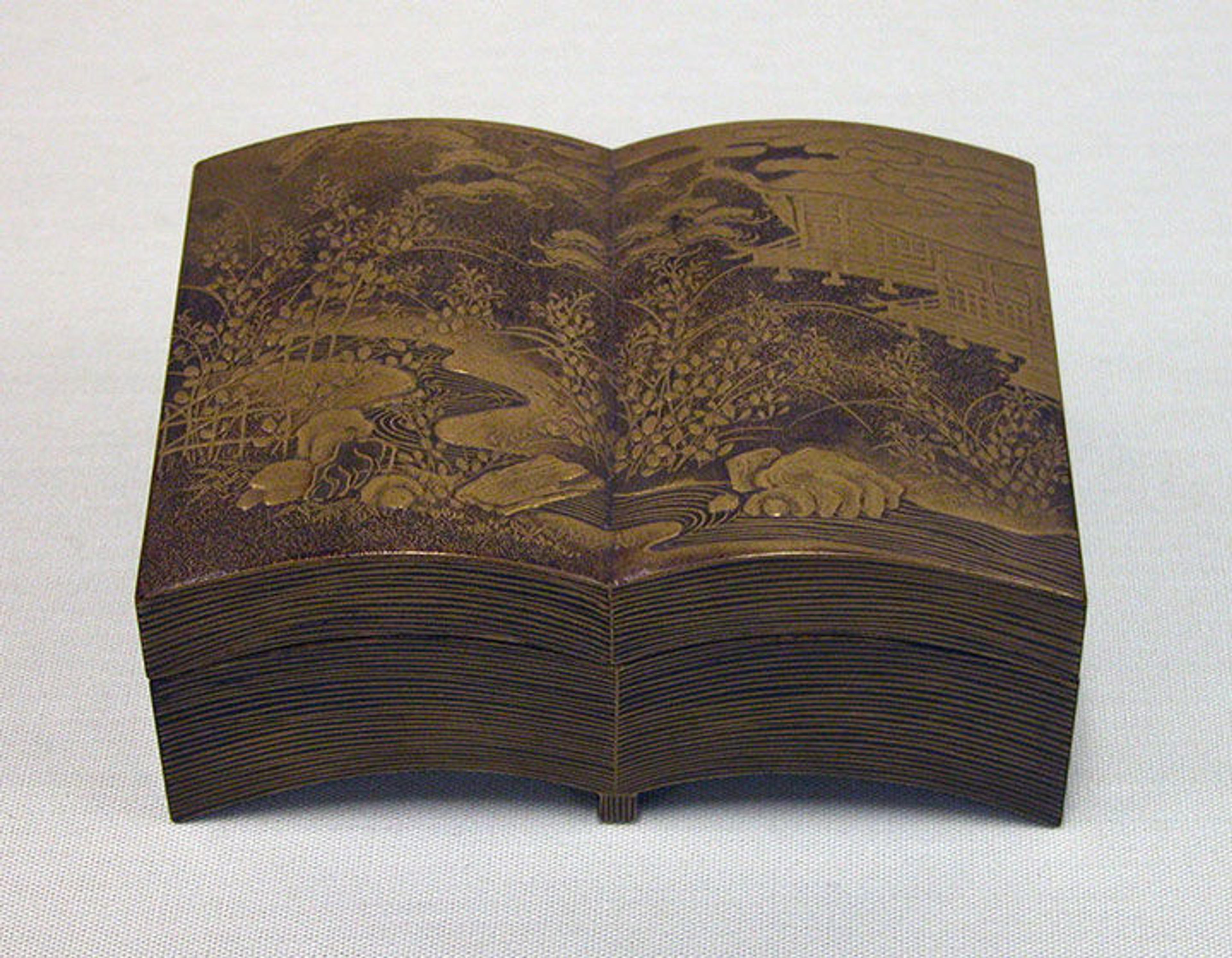
Book flask, ca. 1740–50. British, Staffordshire. Salt-glazed stoneware; 2 1/4 x 1 3/4 in. (5.7 x 4.4 cm). The Metropolitan Museum of Art, New York, Gift of Mrs. Russell S. Carter, 1945 (45.12.28)
«More than ever, bookish professionals and the general public alike are attracted to books as physical objects and admire them for their beauty, historical significance, structural properties, and emotional currency. Few know, however, that people all over the world have been making, collecting, and presenting faux book objects that imitate all kinds of books, from austere religious tomes to beautiful books of poetry. I call these objects blooks (a combination of "book" and "look"). Blooks reflect our devotion and respect for the form and for each other, and have a parallel history to that of books, reaching back 1,000 years.»
For those of you who are familiar with my Grolier Club exhibition last winter, Blooks: The Art of Books That Aren't, you will know that I am an obsessive collector of blooks, and have amassed a personal collection of over 600 objects. One doesn't have to search too far to find blooks, in fact, as they are ubiquitous. The Met has a small but diverse selection of authentic and reproduction blookish curiosities that are housed in the store rooms and study collections of the Departments of Medieval Art and The Cloisters, European Sculpture and Decorative Arts, Musical Instruments, and the American Wing. I'd like to share some of these with you, as none are on display; however, all are available for viewing in The Met's online collection.
Ceramic blooks have been made as novelty items since the 16th century, and were often made to be given as gifts and sold as souvenirs. Mostly they are beautifully decorated vessels, made in a tremendous array of sizes, used for containing and dispensing liquids. Probably the most well-known blook in The Met collection (shown below) is a little ceramic hand warmer with the inscription on its fore-edge, "The Gift Is Small, Good Will Is All." A reproduction of this object was on sale for many years in The Met Store. A second British hand warmer (shown at the top of this post), made in Staffordshire, is about the same age and coloring, but made of different materials. The dispensing hole on the Staffordshire flask is on the fore-edge and features a three-dimensional design.

Hand warmer or flask, first half 18th century. British, Bristol. Tin-enameled earthenware; 5 1/8 x 3 1/4 in. (13 x 8.3 cm). The Metropolitan Museum of Art, New York, Rogers Fund, 1937 (37.123.3)
Humor is a common theme in blooks. In the mid-19th century, the potters of Bennington, Vermont, used humorous spine titles to increase interest in their many versions of book flasks. While not all Bennington flasks sport titles, those with them are often humorous. Examples include Battle of Bennington, Hermit's Delight, Departed Spirits, and, as seen in The Met's flasks shown below, Hoo Doo Bible and Kossuth's Life & Suffering.

Left: United States Pottery Company (1852–58). Book flask, 1849. Made in Bennington, Vermont, United States. American. Mottled brown earthenware; H. 6 in. (15.2 cm). The Metropolitan Museum of Art, New York, Gift of Mrs. Stanley Herzman, 1984 (1984.395.12). Right: United States Pottery Company (1852–58). Book flask, ca. 1849–58. Made in Bennington, Vermont, United States. American. Mottled brown earthenware; H. 10 3/4 in. (27.3 cm). The Metropolitan Museum of Art, New York, Gift of Constance R. Brown, 1939 (40.150.310)
It may surprise you to know that there are many genres of musical instruments and mechanical novelties made in book form, among them keyboard and bellows instruments, Shaker pitch pipes, French serinettes (bird organs), phonographs, radios, and more. The Department of Musical Instruments has in its collection several original and reproduction book-style instruments that include a book harmonium and a bible regal, as well as a wooden Shaker pitch pipe formed in the style of a plain leather-bound book representing a prayer book or bible.
The book harmonium (an organ) shown below has a range of two octaves and seven notes. It is made in the form of four folios covered with tooled leather and bears the title Traité des Pais Bas. The engraving pasted to the interior of the cover illustrates the Supper at Emmaus. The lever at the left operates the bellows.

Book harmonium, 19th century. France or Germany. Wood, leather, paper, various materials; L. (perpendicular to keyboard) 33.4 cm, W. 48.8 cm, D. (with lid) 32.2 cm, 1-octave span 15.5 cm. The Metropolitan Museum of Art, New York, The Crosby Brown Collection of Musical Instruments, 1889 (89.4.1668)
The single-volume bible regal shown below is an early 20th-century reproduction based on 17th-century models.

Bible regal, early 20th century. German. L. 1 ft. 7 in., W. 1 ft., D. 8 in. (dimensions of closed case). The Metropolitan Museum of Art, New York, The Crosby Brown Collection of Musical Instruments, 1889 (89.4.2027)
Another object of interest in the Department of Musical Instruments is a Shaker pitch pipe. While Shakers prohibited the use of musical instruments, they did allow the local production of pitch pipes, and many were made in book form. Wooden whistle-type pitch pipes were constructed in large numbers throughout during the 18th and early 19th centuries to serve church choirs and singing schools. This pitch pipe is fitted with an open-centered, cork-tipped plunger, graduated diatonically by pitch letters with scratched-in marks for recalibrating the pitch.

Pitch pipe, 19th century. American. [Cherry], cork; L. 17.2 cm (6 7/8 in.), H. 9.4 cm (3 3/4 in.), W. 27 cm (1 1/8 in.). The Metropolitan Museum of Art, New York, The Crosby Brown Collection of Musical Instruments, 1889 (15.132)
The Department of Medieval Art and The Cloisters has in its collection a curious early 20th-century reproduction of the 11th-century Cumdach of the Stowe Missal. A cumdach, or book shrine, is an Irish form of reliquary case made for books associated with important religious figures. Only five early examples of cumdachs exist.

Book shrine, Cumdach of the Stowe Missal, early 20th century (original dated 1025–52). Irish. Wood, brass, silver gilt, glass cabochons; Overall: 7 1/2 x 6 1/2 x 2 7/8 in. (19.1 x 16.5 x 7.3 cm). The Metropolitan Museum of Art, New York, Rogers Fund, 1911 (12.4.12)
Throughout Asia, the book motif is commonly used in the decorative arts. Both open and closed books and scrolls of various formats and genres are depicted in textile designs, printed papers, lacquerware, writing sets, costume accessories, ceramics, and lacquerware. The Department of Asian Art is home to two lovely examples of Japanese lacquerware book boxes, representing both open and closed books.
The design of the incense box below imitates a typical Japanese sewn book with paper covers. Suspended from a branch of the tree is a poem-card (tanzaku) bearing a verse from "The Festival of Cherry Blossoms," chapter eight of The Tale of Genji, a classic work of Japanese literature written by the noblewoman and Murasaki Shikibu in the early years of the 11th century, during the Heian period.

Incense container (kōgō) in the form of a book, with the title "Hana no En" (Festival of the Cherry Blossoms), chapter 8 of The Tale of Genji, 19th century. Japanese, Edo Period (1615–1868). Lacquer on wood with shell appliqué, powdered gold and silver; H. 5/8 in. (1.6 cm), W. 3 in. (7.6 cm), L. 4 1/2 in. (11.4 cm). The Metropolitan Museum of Art, New York, Gift of Mrs. George A. Crocker (Elizabeth Masten), 1937 (38.25.184a, b)
The open book illustrated below depicts the pages of an ehon, or illustrated book, with garden scenes.

Box in the shape of an open illustrated book, late 19th century. Japanese, Meiji period (1868–1912). Lacquer on wood with powdered gold; H. 1 7/8 in. (4.8 cm), W. 3 in. (7.6 cm), D. 4 1/4 in. (10.8 cm). The Metropolitan Museum of Art, New York, Bequest of Stephen Whitney Phoenix, 1881 (81.1.260)
If you are interested in learning more about blooks, please visit my blog or check out my book Blooks: The Art of Books That Aren’t, which can be purchased in person at The Met Store or read in the Thomas J. Watson Library.